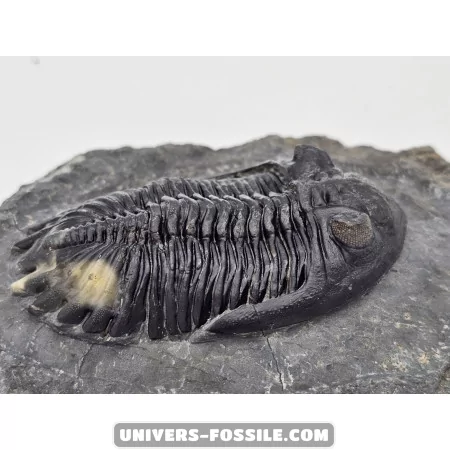Hollardops Trilobites | Fascinating Fossils of Ancient Marine Life

Welcome to the world of Hollardops Trilobites! Delve into the intriguing history of this extinct species of trilobites, a captivating group of marine arthropods that inhabited the Paleozoic oceans millions of years ago.
Anatomy:
- Segmented Body: Hollardops trilobites featured a segmented body divided into three parts - the cephalon (head), thorax (body), and the pygidium (tail).
- Calcified Exoskeleton: Their outer shell, made of chitin and calcite, offered robust protection from predators.
- Compound Eyes: Hollardops sported large compound eyes with numerous small hexagons, granting them a panoramic view of their surroundings.
- Antennae: Though rarely preserved in fossil records, it is believed that Hollardops possessed antennae for environmental detection.
- Segmented Legs: These trilobites utilized their segmented legs to navigate the seabed, foraging for sustenance.
Engage with the mesmerizing legacy of Hollardops Trilobites and acquaint yourself with their unique anatomical features, shedding light on the ancient ecosystems they once inhabited. Uncover the mysteries of these incredible creatures and embark on a journey through time to explore the wonders of prehistoric marine life.
Hollardops Trilobites
Hollardops trilobites were ancient marine arthropods that inhabited the seas during the Middle to Upper Devonian period, approximately 390 to 370 million years ago.
Habitat:
Fossils of Hollardops have been discovered in geological formations across different regions worldwide, including Morocco, Spain, Germany, and the Czech Republic. These findings offer valuable insights into the evolution and distribution of this trilobite species.
Lifestyle:
Believed to be benthic creatures, Hollardops trilobites resided on the seafloor, scavenging for food in the substrate. With their segmented appendages, they foraged for organic detritus and small organisms, serving as both predators and prey in the marine ecosystem.
Predators and Extinction:
Hollardops were preyed upon by cephalopod mollusks and predatory fish, despite their sturdy exoskeleton providing some defense. The species eventually faced extinction along with other trilobites, marking the end of their dominance in the ancient seas.
Hollardops Trilobites
The Hollardops trilobites were fascinating creatures that roamed ancient oceans millions of years ago. These ancient marine arthropods were part of the larger group of trilobites, which were among the most successful and diverse organisms of their time.
Trilobites, including the Hollardops species, eventually became extinct by the end of the Permian period around 250 million years ago, during the mass extinction event that wiped out most life on Earth. The exact causes of trilobite extinction remain a topic of debate among paleontologists, but it is likely they were influenced by climatic changes, geological events, and evolutionary pressures.
Despite their extinction, Hollardops trilobites and other members of their order continue to fascinate scientists and paleontology enthusiasts worldwide. Their well-preserved fossils offer valuable insights into the biodiversity and evolution of ancient oceans, allowing us to better understand the history of life on Earth.
In conclusion, Hollardops trilobites are fascinating examples of the diversity of ancient marine life. Their fossils are precious treasures that allow us to travel back in time and explore the mysteries of prehistoric oceans.
